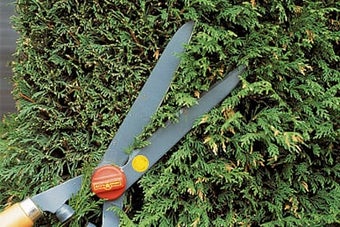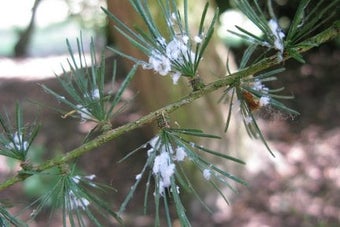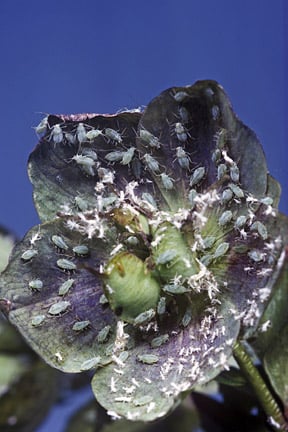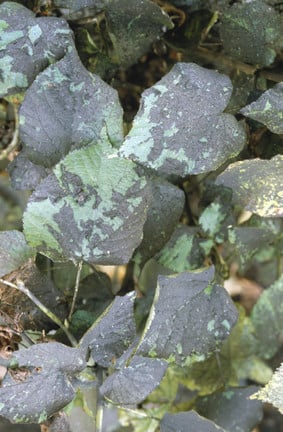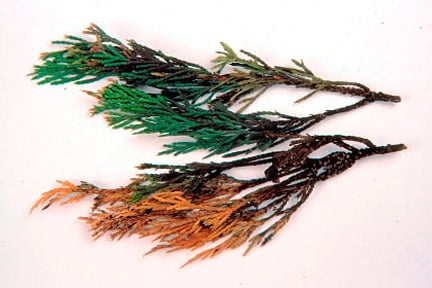
Quick facts
Common name - Cypress aphid
Scientific name - Cinara cupressi
Plants affected - Cupressus macrocarpa, Lawson's cypress (Chamaecyparis lawsoniana), Leyland cypress (× Cuprocyparis leylandii) and Thuja
Main symptoms - Conifers suffer browning of the foliage in summer which can be extensive
Most active - April-June
What is cypress aphid?
Cypress aphid is a blackish brown -sucking insect that feeds on the stems of some hedging conifers (Cupressus species especially C. macrocarpa, Thuja occidentalis, Chamaecyparis lawsoniana and x Cuprocyparis leylandii) in early summer. This often causes a gradual drying up and browning of the foliage.
Aphids are sap-sucking true bugs. They range in size from 1 to 7 mm (¼ in or less) long. Some aphids are known as greenfly or blackfly, but there are species that are yellow, pink, white or mottled. There are more than 500 aphid species in Britain. Some feed on only one or two plant species, but others can be found on a wide range of plant hosts. Many have lifecycles that involve more than one host plant. Almost any plant can be a host to aphids, including ornamentals, vegetables, fruits, greenhouse plants and houseplants. More information on aphids.
There are a number of aphids found on other conifers and aphid like adelgids can also affect these plants.
Symptoms
- Yellowing and shoots in summer; by late summer many of these will be brown and dead. Brown patches on conifers can be caused by a number of other reasons, including disease, but are often caused by growing conditions or routine operations such as trimming. Read more about brown patches on conifers here
- On clipped hedges the dieback can be quite pronounced, with the lower parts often more severely affected than the top
- A black powdery coating of sooty mould may develop on the stems and foliage, this is often the only symptom which will confirm aphids as the cause
- Damaged hedges can recover but it is likely to be a slow process
Management
Following care and pruning guidelines for susceptible conifers during the will improve resistance to cypress aphid damage.
Aphids form the basis of many food chains and it is not unusual to have some of these animals in a healthy balanced garden ecosystem. On established trees aphids can usually be considered part of the they support, natural enemies will normally reduce numbers during summer. On conifers however this is not always the case and small populations of some species can cause browning.
- Where possible tolerate populations of aphids
- Check conifers frequently from spring onwards so action can be taken before a large population has developed
- Use finger and thumb to squash aphid colonies where practical
- Encourage aphid predators in the garden, such as ladybirds, ground beetles, hoverflies, parasitoid wasps and earwigs. Be aware that in spring aphid populations often build up before natural enemies are active in sufficient numbers and then give good control
- Once aphid damage has occurred renovating the hedge can be attempted however the host conifers are often intolerant of hard pruning. Information on hedge selection can be found here
Biology
The greyish brown aphids are active from May to November, reaching peak numbers in early to mid-summer. This is one of the possible causes of browning in susceptible host conifers and can be particularly prevalent on Lawson's cypress (Chamaecyparis lawsoniana) and Leyland cypress (× Cuprocyparis leylandii) hedges.
These aphids suck from the stems and even quite light populations can have a significant effect. It can, however, be difficult to see them as although the aphids are 2-4 mm long (about 1/8 in) their colour matches that of the . A useful confirmation of aphid damage is the presence of a black sooty mould on the stems and/or foliage, as there are other causes of dieback on conifers. Other causes of dieback include poor establishment, weather damage such as drought, scorching caused by wind or extreme temperatures, excessive clipping of a hedge, and root diseases such as honey fungus and Phytophthora root rot.
